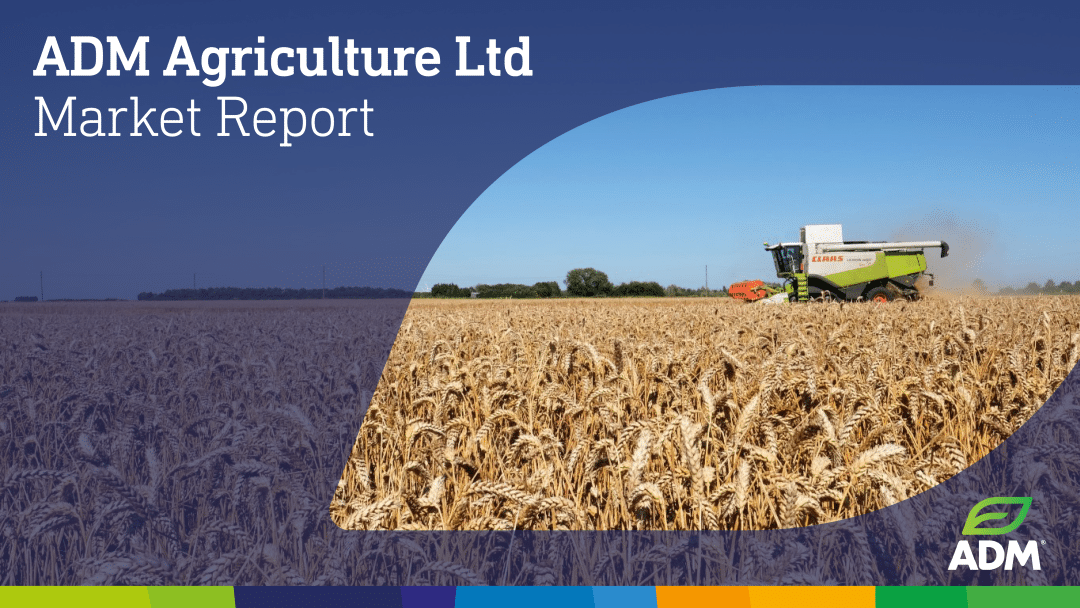WELCOME TO THE ADM AGRICULTURE WEEKLY MARKET REPORT
Wheat
Chicago wheat futures (May ’25) experienced early-week declines due to speculative selling but rebounded to close 1.75c/bu higher. The USDA WASDE report maintained ending stocks at 1.154 billion bushels, with export forecasts unchanged at 62.2 million bushels. The report also highlighted the uncertainty tariffs are introducing into market estimates.
Key Factors:
- Warmer, wetter Midwest conditions are expected to improve crop development, keeping prices under pressure.
- MATIF wheat futures are largely unchanged week-on-week, with a potential seasonal uptrend into mid-to-late May, though a strong euro continues to limit export competitiveness.
- A Russian missile strike on Odesa raised concerns over Ukraine’s wheat exports, while uncertainty remains over a US-Ukraine ceasefire. Despite tensions, Black Sea wheat shipments from Ukraine, Romania, and Bulgaria continue to supply global markets, curbing price spikes.
- The EU’s 25% tariff on US corn imports could impact trade flows and influence long-term wheat demand.
- Marginal gains were recorded on London wheat futures: supported by a weaker pound, but UK wheat remains uncompetitive in export markets.
Outlook
Seasonal price trends in MATIF wheat may offer some upside, but broader market uncertainty persists. Improved US crop conditions are likely to weigh on prices, while geopolitical risks, including Russia-Ukraine tensions and shifting trade policies, add to volatility. With continued global supply from the Black Sea region and currency fluctuations affecting competitiveness, market participants remain cautious in an increasingly uncertain trading environment.
Malting Barley
Feed and malting barley markets are facing mixed conditions, with some support in feed barley due to export interest, while malting barley remains slow and lackluster.
Key Factors:
- Old crop malting barley remains inactive with prices depressed due to a lack of demand.
- New crop plantings are progressing well in the EU, particularly in France, the UK, and Denmark, with favourable conditions. The outlook for supply in Europe seems stable, which is keeping markets lower.
Outlook
Malting barley is slow with low demand, but good growing conditions in the EU suggest stable supply.
Feed Barley
Key Factors:
- Support for feed barley markets has emerged, driven by export interest, particularly from the Netherlands, where the UK is starting to export more, potentially opening up larger volumes.
- Despite this, farmer selling remains slow, and domestic markets are subdued, with barley losing competitiveness in feed rations.
- New crop basis feels pressured as UK plantings progress, and there’s limited demand, making the UK uncompetitive for export.
Outlook
Feed barley markets are supported by exports, but domestic demand is weak. The new crop basis remains under pressure.
Rapeseed
Agricultural markets declined again, driven by escalating geopolitical tensions and tariffs. China imposed a 100% tariff on Canadian oil and meal in retaliation for Canada’s EV tariffs. Ontario Premier Doug Ford’s threat of a 25% electricity tariff led Trump to double aluminium and steel tariffs, with Ford responding by suggesting a full electricity cutoff to the US. By midweek, Canada and the EU announced 25% tariffs on US imports, adding further uncertainty.
Key Factors:
- CBOT Soybeans fell 25 cents to $10/bushel. The USDA WASDE report kept US stocks and acreage unchanged, with global ending stocks cut by nearly 3 mmt.
- Hot, dry weather in Brazil and Argentina aids harvest. Focus will shift to US spring planting.
- Crude Oil prices rebounded from new lows amid Ontario-US tariff tensions. The EIA expects tight global oil markets through mid-year.
- Canadian prices hit new lows due to trade disputes. StatsCan’s 2025/26 seeded acreage estimate of 21.70 million acres may face downward revision.
- Uncertainty over Canadian oil and meal exports to China and the US could shift trade toward the EU, widening the GMO vs. non-GMO price gap.
Outlook
With ongoing trade disputes and shifting supply chains, market volatility is likely to persist. Soybean markets will monitor US planting conditions, while crude oil and canola markets remain sensitive to geopolitical developments. Rapeseed prices may stay weak through the month amid trade realignments.
Oats
European oat markets remain sluggish, with US and EU buyers less concerned about potential US tariffs on Canadian oats. Repeated extensions and the expectation that the EU will also face tariffs have eased fears of supply tightening, reducing urgency to purchase.
Key Factors:
- The European market remains well supplied, but a reduction in Canadian oat plantings could tighten global availability heading into Q4 2025.
- Drilling is set to begin across Europe, with market focus shifting to crop development and its impact on milling oat prices.
- Recent dry weather in the UK has supported near-optimal spring oat planting, though crop progress remains key.
- Old crop demand remains weak, though potential export interest could provide support to the UK market.
Outlook:
Oat markets remain stagnant, awaiting fresh developments to drive trading activity. Supply dynamics and spring planting progress will be key in shaping market direction in the coming months.
Pulses
Spring drilling continues apace, though the main news this week is the closure of the SFI24 programme to new applicants late on Tuesday. The market is now assessing the potential impact this will have on the pulse area.
Key Factors:
- Trade War 2.0 continues with a steady stream of new tariffs, retaliatory tariffs, and reversals, creating a very ‘dynamic’ economic landscape. The GBP and EUR continue to see relative support amid USD weakness, which hampers UK export competitiveness on pulses but helps maintain the affordability of USD-denominated feedstuffs like Soybean Meal.
- Drilling is progressing well across the UK, aided by favourable conditions. The upcoming week remains relatively dry, though temperatures will stay cooler. However, the major news for pulses this week is the Government’s announcement on Tuesday that they will stop accepting fresh applications for SFI24. This decision is likely to prompt many farmers to reconsider their drilling plans for CY25 and adjust their crop rotation, potentially increasing the UK pulse area as a result, as people look for spring alternatives.
- If you’ve been affected by this announcement and are now seeking alternatives, contact your Farm Trader. They can discuss the availability of spring seed options and the marketing strategies available, including Pool, futures-related contracts, and buy-back agreements to help you maximise returns from what can be a challenging crop to market effectively.
- New crop premiums remain firm. However, as drilling progresses, we expect them to soften. If the area initially intended for SFI applications shifts to pulses, premiums may weaken further. Beans still appear £35-40/mt too expensive compared to imported feedstuffs.
- Old crop pea demand remains variable, with slow processor demand. However, the new crop is steadily coming into focus, and buy-back contracts offer a structured selling opportunity, linking growers to advanced pulse processing facilities in Europe.
Outlook:
With drilling progressing well and the cessation of new applicants for the SFI24 programme, market conditions may become more volatile. Farmers should consider strategic marketing options while ensuring strong crop management for optimal yields.
PGRO membership provides valuable pulse agronomy resources and advisory support.
Seed
Spring drilling is progressing well, taking advantage of favourable weather conditions.
Key Factors:
- We have limited availability on spring barley and spring peas, delivery can be arranged quickly.
- Interest is increasing on pulse and linseed due to the closure of the SFI Schemes, with strong supply and attractive buy-back contracts available.
- There is continued demand with Maize seed, with a diverse range of top-performing varieties available.
Outlook:
With momentum building in key crop sectors, timely purchasing is advised to secure preferred seed varieties. For the latest market updates and tailored seed solutions, reach out to your ADM Agriculture farm trader.
Our Winter Seed catalogue is now live, browse our varieties here. We also have Spring and Maize catalogues available.
Our seed specialists are on hand to help with any queries you may have, call our friendly team on 01427 421200.
Fertiliser
Global energy and fertiliser markets remain volatile, influenced by shifting supply dynamics, geopolitical tensions, and trade policies. While US natural gas prices softened due to rising production, European prices rebounded on colder forecasts. Fertiliser markets are navigating supply constraints, with demand fluctuations and trade uncertainties playing a key role in price movements.
Key Factors:
Natural Gas
- US futures fell below $4.10/MMBtu despite strong LNG exports, with production averaging 105.8 bcfd. The EIA raised its 2025 price forecast to $4.20/MMBtu due to tighter inventories.
- European gas rebounded to €42.5/MWh on colder forecasts, with EU storage at 36.2% and a 90% target for November. Ongoing geopolitical risks persist.
Ammonia
- Prices remain soft as supply outpaces demand, though renewed European import interest and potential Indian purchases could slow declines.
Nitrates
- Strong spring demand supports European prices, with Brazilian interest adding stability. UK prices lag due to limited imports, raising supply concerns.
Urea
- A potential Indian tender could stabilise prices. US and Brazilian markets remain weak, while the UK holds firm amid tight supply.
Potash
- Prices may rise as US tariffs on Canadian imports create uncertainty. Spring demand is tightening UK supplies.
Phosphates
- Prices are climbing due to supply constraints, with India struggling to secure imports. A large Ethiopian tender adds further upward pressure.
Outlook
Natural gas remains volatile, with weather and geopolitical risks influencing prices. Fertiliser markets face shifting trade dynamics, with India’s potential urea purchases and phosphate shortages driving near-term trends. The potash market remains uncertain amid evolving US tariff policies.
Our fertiliser specialists are on hand to help with any queries you may have, call our friendly team on 01427 421200.
| £/€ | £/$ | €/$ |
|---|---|---|
| 1.1911 | 1.2948 | 1.0869 |
| Feed Barley £ | Wheat £ | Beans £ | Oilseed Rape £ | |
|---|---|---|---|---|
| Mar 25 | 145-160 | 173-188 | 205-215 | 395-405 |
NB: Prices quoted are indicative only at the time of going to press and subject to location and quality.
Although ADM Agriculture takes steps to ensure the validity of all information contained within the ADM Agriculture Market Report, it makes no warranty as to the accuracy or completeness of such information. ADM Agriculture will have no liability or responsibility for the information or any action or failure to act based upon such information. ADM Agriculture cannot accept liability arising from errors or omissions in this publication. ADM Agriculture trade under AIC contracts which incorporate the arbitration clause. Terms and Conditions of Purchase.
On every occasion, without exception, grain and pulses will be bought by incorporating by reference the terms & conditions of the AIC No.1 Grain and Peas or Beans contract applicable on the date of the transaction. Also, we will always, and without exception, buy oilseed rape and linseed by incorporating by reference the terms & conditions of the respective terms of the FOSFA 26A and the FOSFA 9A contracts applicable on the date of the transaction. It is a condition of all such transactions that the seller is deemed to know, accept and understand the terms and conditions of each of the above contracts.


